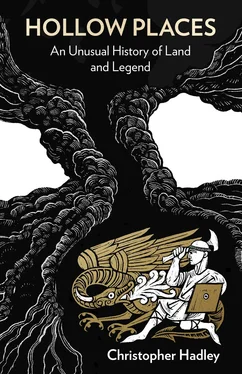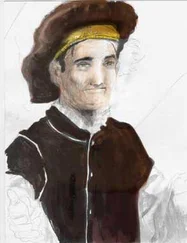1 ...8 9 10 12 13 14 ...22 Was it originally planted to mark the site of an early Christian saint’s cells? In about 940 the Welsh King Hywel Ddathreatened a fine of sixty sheep for felling yews associated with saints. Or did people gather around the yew long ago? Surviving lone trees may have been moot trees – meeting trees – like the Ankerwycke Yew at Runnymede where King John might have signed Magna Carta , and Henry VIII was said to have met Anne Boleyn for the first time. From Anglo-Saxon times until the modern period many southern and Midlands counties were divided into Hundreds, which took their names from the original moots or meeting places of the Hundred Court. Such places were often marked by a significant tree or stone. The Pelhams were in the Edwinstree Hundred – literally Edwin’s Tree– and early records indicate that the meeting place was somewhere in the Pelhams. Place-name historians have guessed that Meeting Field housed the tree, although that name appears for the first time in the late nineteenth century. Great Pepsells was much closer to the centre of the Hundred, bounded by three parishes and fed by ancient paths and trackways. Was Edwin’s Tree a venerable old yew? One early medieval source links Edwin’s Tree to woodland, and woodland may hide the reason for a lone Hertfordshire yew and that track to nowhere.
At the turn of the nineteenth century, villagers across Essex and Hertfordshire were warned not to be startled by strange lights on the horizon. The engineers of the Ordnance Survey were at large, hauling Ramsden’s immense horse-drawn theodolite from village to village, along with their 100-foot steel chains, twenty-foot high white flags, and their brand-new draught-proof white lights. This was the earliest of the surveys made some eighty years before the large-scale 25-inch with its individual trees. The maps would be plotted at just 1 inch to the mile, but it was a revolution in cartography.
There are remarkable preliminary pencil drawings, made at a larger scale than the published sheets. The fields seem to stand out from the paper in relief, like anatomical specimens in cross section, finely hachured to look more like a coral reef than rural Hertfordshire. Zoom in and the map covering Great Pepsells is heavily shadowed as if seen through storm clouds, the gathering clouds of the Peninsular War perhaps, which hurried the surveyor’s hand. The field boundaries, which would disappear from the published version, are clearly drawn in, and the house and settlements picked out brightly in red ink. Right in the centre of the drawing between the little red dots labelled Johns Pelham and Lily End is Hormead Park Wood, the woodland that adjoins the south-west corner of Great Pepsells. But it is much larger on the 1 inch than it is today. Instead of the tidy rectangle of later maps, the wood meanders across the fields of Furneux Pelham drawing a shape far more typical of an original ancient woodland boundary.
But were these early small-scale maps accurate? They were surveyed in two parts. First the large-scale trigonometry was completed, and then a second survey filled in the resulting triangles with fields and roads, rivers and hills: this was the interior or topographical survey. Map historians write that the very first OS sheets of Kent had been plotted at the end of the eighteenth century to the exacting standards of the pioneering military map-maker William Roy, who insisted that ‘The boundaries of forests, woods, heaths, commons or morasses, are to be distinctly surveyed, and in the enclosed part of the country at the hedge, and other boundaries of fields are to be carefully laid down.’ It was a slow and expensive process, so when they came to do Essex, the chief surveyors were told to make it faster and cheaper, but in the end they only sacrificed the exact shape of fields. So while the 1804 sheets might not be as detailed as the later large-scale maps, it was a proper military survey, and the towns, villages, rivers and hills were plotted accurately. As were the woods, because they could provide cover for ambushes – a French invasion was still feared when the surveyors were at work.
Assured of the map’s accuracy, I laid a copy over later maps, and found that where a finger of the wood points to its northernmost edge, it precisely matches the shape of the boundary between Great and Little Pepsells . (I use italics in an effort to convey the excitement I felt at this discovery. It was as if I had unearthed a fragment of an ancient cuneiform clay tablet and found it joined up perfectly with another found years before to reveal the location of Noah’s ark.) Was it an echo of the northernmost tree-line of Great Hormead Park Wood? Did an ancient yew tree once mark this boundary? Yews, as well as other trees, had been used as meres or boundary markers since Anglo-Saxon times. And there was that telltale path that the yew had straddled, hence the stile in its split trunk, a path terminating at a tree that is no longer there.
There is a later map, one of the last private county maps made before the OS swept all before it: Mr Bryant’s 1822 map reveals that sometime between then and the start of the century, the section of Hormead Park projecting into Furneux Pelham was grubbed up, or, in the terms of the Lord of the Manor’s tenancy agreementfor the land, the timber was felled, cut down, stocked up, peeled, hewn, sawn, worked out, made up and carried away. Why was the Yew left untouched?
The same military zeal that saw the birth of the Ordnance Survey saw the felling of thousands of trees not for timber for ships or for the war effort as is sometimes said, but simply because corn prices went through the roof. The militaristic language used to describe the campaigns against Napoleon were used to describe the agricultural revolution against the inefficient use of land. ‘Let us not be satisfied with the liberation of Egypt or the subjugation of Malta,’ wrote the first President of the Board of Agriculture, in 1803. ‘Let us subdue Finchley Common; let us conquer Hounslow Heath, let us compel Epping Forest to submit to the yoke of improvement.’
The transformation of the ancient clayor heavy-lands of Eastern England from medieval bullock fattening into intensive arable is now recognised as one of the key stages of the agricultural revolution. Arable land in the Pelhams increased by 130 acres in the half-century after 1784, but pasture fell by only three. It was woodland and hedgerow that gave way to the plough. Hertfordshire was one of the counties with the least waste – or uncultivated land – as so much of it had already been enclosed and cultivated in the Middle Ages; little wonder then that farmers were grubbing up trees and not just scrub when corn prices were so high. ‘What immense quantities of timber have fallen before the axe and mattock to make way for corn,’ wrote one observer in 1801.
If you are felling and grubbing up fifteen acres of trees, felling them by hand and digging up the roots, when you get to an ancient yew, perhaps some thirty foot or more in circumference, magnificent and stately and – more importantly – notoriously hard to chop down, you might well leave it standing, along with its stile that allowed people on the track from the north to clamber into the woodland.
It was not only a mere but also a shelter. The presence of these evergreens in churchyards and elsewhere is often said to be because of the shelter they offer. Deer have been spotted sheltering under a yew at Ashridge Park, in Hertfordshire, and there are yews on the banks of John of Gaunt’s deer park at King’s Somborne, probably dating from when the deer park was set out in the thirteenth century. Of course, they can shelter more than game. An ancient yew at Leeds Castle in Kent was lived in by gypsies in 1833, and the hollow Boarhunt yew in Hampshire reputedly housed a family for a whole winter.
Читать дальше












